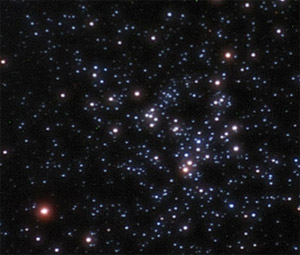Sitting beside a sea, comforting on the beach sand with legs stretched, relishing the cool sea breeze, peeping at the dark clear night sky pondering something is really exciting, yeah??
Ever got such a kinda situation to bask the beauty??
Yeah? But halt here....! Why is night sky always "dark"??? Ever wondered?
Why, at first look, you might say, "This is too fundamental. Too simple and obvious". But it isn't so simple as it seems to be! This is a famous and not so easy paradox called as "Olbers' paradox" which has just been solved to some agreeable extent.
"Why night sky appears dark, huh?"
When you put forth this question, you are likely to get the most probable explanation, "During night, the sun is on the other side of us. So, we feel the sky dark."
But it is not quite convincing, for we aren't high school kids anymore. Smarter children, who have a good sense of intelligence would pose a contradiction to this explanation, which goes, "Science says that there are over 200 billion stars in our galaxy - the Milky Way. So, what about the light emanating from those stars? Wouldn't they light up the sky??"
 |
| If light from almost every star reaches the earth, the sky would look like this. |
This question has a salutary logical point. There are almost uncountable number of stars on the sky(in the Universe). These stars, being self-luminous, would definitely give off light which should reach the earth. If this is true, the sky would look at least like this:-(see the image on the right)
But in reality this doesn't seem to be holding good. What has happened to the light rays which have been emanating from these stars? What is preventing them from reaching the earth?
The most expected answer is "Stars(other than the sun) are excessively far from the earth and therefore, the rays exhaling from them suffers an appreciable loss in intensity. So, the night sky is dark". This explanation would render us a little better view on the topic. But what is that which is exactly responsible for such a loss in intensity??
 |
| Picture describing Oblers' paradox. |
One might say that every galaxy contains more number of planets and other dust particles, than the number of stars. So, these plants, asteroids, comets and dust would simple block "some" of the light rays from the distant stars from reaching the earth. But remember, they block only "some".
Also, the distribution of stars is not uniform, but they hide behind one another so that it solves the paradox to a little extent.
But the main and more accurate answers are as follows:
1)The Universe is expanding. So, light from the distant stars are "red-shifted" to obscurity.
2)The Universe is young. Light from distant stars hasn't even reached us yet!(may sound funny for beginners)
Speaking about the first explanation, the Universe is said to be expanding frantically. The Big Bang Theory supports this view. So, distant stars which are moving at a considerably high speed will be "red-shifted". To elaborate, as these stars are moving at a high speed relative to the earth, the wave-length of the visible light emitted by them would be shifted towards red.(red-shift)
But some physicists put-forth a counter-argument that light of lower wavelength like gamma rays, x-rays and UV-rays would also be red-shifted to "visible region" and this would compensate the former.
Whatever be it! But the second point has a good significance. The Universe is young and degenerate. So, we only see the part of Universe less than 15 billion light years away. Objects which are more than 15 billion years old are too far away for their light to reach us.
Thus, Oblers' paradox is somewhat resolved. Contradictory thoughts are welcomed. Cheers......!
__________________________________________________________
(pictures are taken from the web. and link courtesy - wikipedia)

very interesting blog.. :)
ReplyDeletewell, thank you very much! BTW, it's your marvelous comments here, that makes me passionate on writing these stuff! Gracias, Varadha yamunan.
ReplyDeleteOne comment is there to u r answr abt red shift.. plz visit is link: http://bergundiesscience.blogspot.com/2010/07/red-shift.html...
ReplyDeleteI have a theory. The light from the furthest stars haven't reached us yet because we see them as they were when the light left them but the further we look the further back in time we see so that far back in time the universe had not started, the stars had not formed therefore the light from the very beginning of the star's life has not reached us yet.
ReplyDeleteHow do we know that the Earth is round?
ReplyDeleteFlat Earth Book
aşk kitapları
ReplyDeletetiktok takipçi satın al
instagram beğeni satın al
youtube abone satın al
twitter takipçi satın al
tiktok beğeni satın al
tiktok izlenme satın al
twitter takipçi satın al
tiktok takipçi satın al
youtube abone satın al
tiktok beğeni satın al
instagram beğeni satın al
trend topic satın al
trend topic satın al
youtube abone satın al
takipçi satın al
beğeni satın al
tiktok izlenme satın al
sms onay
youtube izlenme satın al
tiktok beğeni satın al
sms onay
sms onay
perde modelleri
instagram takipçi satın al
takipçi satın al
tiktok jeton hilesi
instagram takipçi satın al pubg uc satın al
sultanbet
marsbahis
betboo
betboo
betboo
mmorpg oyunlar
ReplyDeleteinstagram takipçi satın al
Tiktok Jeton Hilesi
Tiktok jeton hilesi
antalya saç ekim
takipçi
instagram takipçi satın al
metin2 pvp serverlar
TAKİPÇİ
Yeni perde modelleri
ReplyDeletesms onay
mobil ödeme bozdurma
nft nasil alinir
Ankara Evden Eve Nakliyat
trafik sigortası
dedektör
web sitesi kurma
aşk kitapları
smm panel
ReplyDeletesmm panel
İs İlanlari
İnstagram Takipçi Satın Al
hirdavatciburada.com
Beyazesyateknikservisi.com.tr
servis
tiktok jeton hilesi